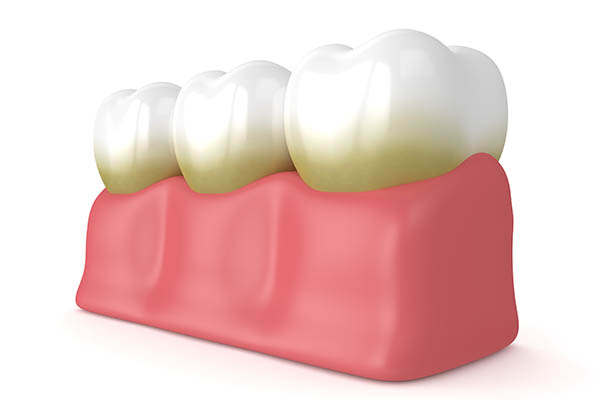When Is a Dental Bridge Necessary?

A dental bridge can be used to replace one or a few missing teeth. As the name suggests, these oral restorations bridge gaps between teeth, restoring their appearance and functionality. Dental bridges are customized for each patient to ensure the restoration matches the size and color of the rest of their teeth.
Dental bridges are made up of two main components: abutments and pontics. Abutments are the structures that support a dental bridge (typically crowns placed on both ends of the bridge), while pontics are the artificial teeth that fill up the space left by missing teeth.
Reasons a dentist might recommend a dental bridge
Dental bridges are one of the options patients with missing teeth have to choose from, along with other alternatives like implants and dentures. Bridges can also be combined with dental implants for a more comprehensive solution. Some of the reasons a dentist might deem it necessary to get a dental bridge include:
1. To prevent teeth from shifting
Teeth often move toward any gaps left behind by missing teeth that are not quickly replaced in an attempt to fill up the space. These teeth move out of their proper positioning as they gravitate toward the gap, leading to various malocclusions like crooked teeth, crowded teeth, or temporomandibular joint disorders.
Poorly aligned teeth lead to their own set of dental issues like an increased risk of tooth decay and gum disease due to being harder to clean. Shifted teeth also ruin the appearance of a person’s smile while failing to cover up the gap left by lost teeth. It can make a person self-conscious about their appearance since the condition of the teeth is one of the first physical traits noticed during interactions.
Dental bridges can be used to close up the gap left by missing teeth, preventing the remaining ones from shifting toward the space. It typically takes two appointments over two weeks to replace missing teeth with bridges.
2. For improved aesthetics
Gaps between teeth can be as unsightly as stains or misaligned teeth, but bridges can restore the appearance of lost teeth. Bridges can be customized and placed within two weeks, and patients often get a temporary bridge after their first appointment to protect their prepared teeth and restore their smile.
3. To restore the function of lost teeth
Dental bridges not only return the appearance of missing teeth, they also restore their function. Teeth play an important role in speech and breaking down foods before swallowing. Restoring the function of lost teeth allows patients to enjoy a wider range of healthy foods.
4. To merge with implants for bone preservation
Dental bridges are sometimes combined with implants depending on the location of the gap in the patient's teeth. Bridges are typically anchored on the two teeth closest to the gap, but they can also be attached to implants.
Implants help to preserve bone tissue in the jaw by transferring bite forces into them. Dentists often combine implants with bridges to provide a long-term missing solution for people who have lost most of their natural teeth.
What to expect when getting a dental bridge
Getting a dental bridge typically starts with a dentist examining the patient and going over their preferences to determine the optimal missing teeth solution for them. Getting a traditional bridge placed typically means:
- The patient is injected with a local anesthetic to numb the region being worked on
- The two teeth closest to the gap are prepared for abutments by shaving off enamel from their sides. This step is irreversible, and these teeth will always need a dental restoration to serve as their artificial enamel moving forward
- An impression of the patient’s teeth or a 3D image is sent to a dental lab where bridges are made. Technicians will use the model or impression to make the patient’s custom bridge and send it back to the clinic in a couple of weeks
- A temporary bridge is placed to protect the patient’s teeth while their permanent set is being made
- During a second appointment, the temporary bridge is swapped with the permanent restoration, and adjustments are made as needed to ensure everything fits as intended. Dental bridges can last up to 15 years when properly maintained
Replace missing teeth with a dental bridge
A dental bridge is one of the fastest ways to close up spaces in your smile left by missing teeth. These restorations can be placed in as little as two weeks, and you get a temporary bridge that restores the appearance of your smile at the end of the appointment. Call or visit our Brooklyn clinic to set up a consultation.
Request an appointment here: https://www.gardendentalartsny.com or call Garden Dental Arts at (718) 416-6367 for an appointment in our Brooklyn office.
Check out what others are saying about our dental services on Yelp: Dental Bridges in Brooklyn, NY.
Recent Posts
It is helpful to understand the different types of dental bridges to determine why your dentist may recommend a specific one. All dental bridges accomplish the same goal, which is to replace a missing tooth or a section of missing teeth. However, depending on the patient’s goals and the status of their oral health, a…
Teeth that are severely decayed or fractured may benefit from dental crowns, which cover the damaged portions of the teeth, protecting them and restoring their functionality. A dental crown is crafted to fit the remaining portion of the tooth exactly and permanently bond to it. However, crowns are not perfect, and while they are usually…
When a dental practitioner recommends a dental crown, it may not be up to the patient. These dental devices are used to treat various conditions that cause a tooth to need serious work. When a crown is required, it usually means that the tooth it covers is too far gone to be useful, but it…
When a filling is insufficient or a tooth is malformed, the dentist may suggest a dental crown to protect, cover, and restore the tooth's structure. While receiving a crown may seem strange or scary, it is a routine and safe process that can strengthen the teeth, extend their life, and restore the natural appearance of…


